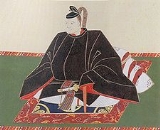
Tokugawa Yoshinao
Encyclopedia
was a Japanese daimyo
of the early Edo period.
, his childhood name was Gorōtamaru. While still a young child, he was appointed leader of first the fief of Kofu
in Kai Province
and later the fief of Kiyosu in Owari Province
. In 1610, he was appointed leader of the Owari Domain
(present-day Nagoya), one of the most important regions in the country, thus founding the Owari-Tokugawa house. A holder of the 2nd court rank, junior grade (ju-ni-i), he had the title of dainagon (major counselor).
Yoshinao's principal wife was Princess Haru, the daughter of Asano Yoshinaga of Kii (whose family was later transferred to Hiroshima), and his concubines included Osai and Ojō no Kata. He had two children: Mitsutomo
, who succeeded him as daimyo of Owari, and Itoko, who married Hirohata Tadayuki, a court noble.
Yoshinao began learning Shinkage-ryū
from Yagyū Hyōgonosuke
at age 16, and was named the 4th sōke
at age 21.
Daimyo
is a generic term referring to the powerful territorial lords in pre-modern Japan who ruled most of the country from their vast, hereditary land holdings...
of the early Edo period.
Biography
Born as the ninth son of Tokugawa IeyasuTokugawa Ieyasu
was the founder and first shogun of the Tokugawa shogunate of Japan , which ruled from the Battle of Sekigahara in 1600 until the Meiji Restoration in 1868. Ieyasu seized power in 1600, received appointment as shogun in 1603, abdicated from office in 1605, but...
, his childhood name was Gorōtamaru. While still a young child, he was appointed leader of first the fief of Kofu
Kofu Domain
The was a han or feudal domain in Kai Province . After the Yanagisawa clan was reassigned to another domain in Yamato Province, Kōfu was ruled as tenryō, on behalf of the shogun, by a hatamoto.- Heads :*Kawajiri clan#Hidetaka...
in Kai Province
Kai Province
, also known as , is an old province in Japan in the area of Yamanashi Prefecture. It lies in central Honshū, west of Tokyo, in a landlocked mountainous region that includes Mount Fuji along its border with Shizuoka Prefecture....
and later the fief of Kiyosu in Owari Province
Owari Province
was an old province of Japan that is now the western half of present day Aichi Prefecture, including much of modern Nagoya. Its abbreviation is Bishū .-History:The province was created in 646....
. In 1610, he was appointed leader of the Owari Domain
Owari Domain
The was a feudal domain of Japan in the Edo period. Located in what is now the western part of Aichi Prefecture, it encompassed parts of Owari, Mino, and Shinano provinces. Its headquarters were at Nagoya Castle. At its peak, it was rated at 619,500 koku, and was the largest holding of the...
(present-day Nagoya), one of the most important regions in the country, thus founding the Owari-Tokugawa house. A holder of the 2nd court rank, junior grade (ju-ni-i), he had the title of dainagon (major counselor).
Yoshinao's principal wife was Princess Haru, the daughter of Asano Yoshinaga of Kii (whose family was later transferred to Hiroshima), and his concubines included Osai and Ojō no Kata. He had two children: Mitsutomo
Tokugawa Mitsutomo
was a Japanese daimyo of the Edo period, who ruled the Owari Domain. He was taught Shinkage-ryū by the Owari Yagyū family. He proved so adept that he was named the 6th sōke by Yagyū Toshikane, and added a number of teaching concepts to the ryū....
, who succeeded him as daimyo of Owari, and Itoko, who married Hirohata Tadayuki, a court noble.
Yoshinao began learning Shinkage-ryū
Shinkage-ryu
' meaning "new shadow school", is a traditional school of Japanese martial arts, founded by Kamiizumi Ise-no-Kami Nobutsuna in the mid-sixteenth century...
from Yagyū Hyōgonosuke
Yagyu Hyogonosuke
or — Toshiyoshi was the founder of the Owari mainline of the Yagyū Shinkage-ryū style of swordsmanship in the early Edo period. He was a son of Yagyū Toshikatsu and a grandson of Yagyū Muneyoshi ....
at age 16, and was named the 4th sōke
Soke
The word soke has several meanings:* Soke , an early Western jurisdictional concept.* Soke or eke is a Tongan stick dance, originating from Wallis and Futuna., a Japanese title meaning "head of the family," and is usually used to denote the headmaster of a school of Japanese martial arts.* Soke of...
at age 21.

